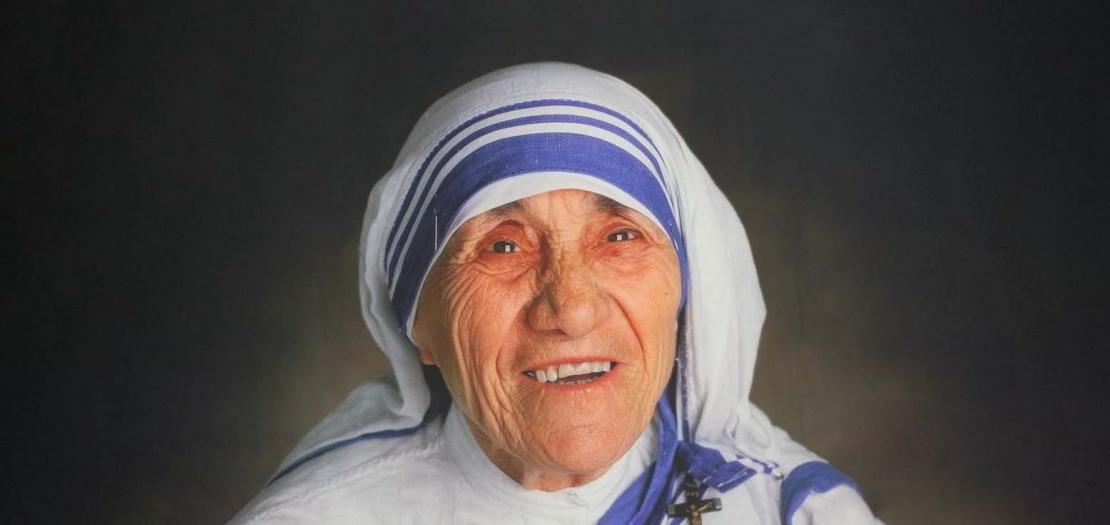Issued by the Catholic Center for Studies and Media - Jordan. Editor-in-chief Fr. Rif'at Bader - موقع أبونا abouna.org

There is some ever-present and spiritual magnetism about St. Teresa of Calcutta, better known as Mother Teresa.
No matter that this year marks the 25th anniversary of her death; her strong charisma remains fresh. It is no less present in a new movie about her life and work, Mother Teresa: No Greater Love, which will premiere on October. 3 in U.S. theaters in more than 960 locations.
The film opens where her mission began: tending the sick, the dying and the destitute of Kolkata. Footage shows her tending to them as in her own voice she proclaims the basis of her mission: “Hunger is not only for a piece of bread. Hunger is for love — the desire, the longing to be loved. The lonely people suffer terrible hunger. And nakedness is not only for a piece of cloth. Nakedness, the loss of human dignity, the respect that you and I long to have, they also long [to have]. That man, lying in the street, eaten up by worms, is a child of God.”
“For Mother it was not the poor. It was the poorest of the poor,” says a priest in the documentary, while looking at the saint’s work in the slums of Brazil.
“She was tough in Jesus. She wanted to love till it hurts,” states one of her Missionaries of Charity sisters. Scenes of her sisters taking care of the poor are intercut with those of Mother Teresa caring for the distressed. One moving scene follows another in rhythmic succession to bring viewers a series of touching and heartwarming moments, including the sisters taking care of handicapped children and babies in one of several orphanages.
Filmed on five continents, the film presents the heart of Mother Teresa’s story, beginning with her work in Calcutta and then spreading globally. From the South Bronx to Rio de Janeiro; from Harlem to San Francisco; from a home for disabled children in the slums of Nairobi, Kenya, to Venezuela; from the Philippines to her own native Albania, she brought loving care and hope both personally and through her Missionaries of Charity, all captured in evocative scenes.
The presentation is one of the hallmarks of this film produced by the Knights of Columbus and directed by Emmy Award-winning documentary filmmaker David Naglieri, whose work includes the feature-length Liberating a Continent: John Paul II and the Fall of Communism. As so well realized in Mother Teresa: No Greater Love, the documentarian makes his subjects come alive, not just a continuous series of historical events with strings of facts. Naglieri draws viewers into the person’s life — in this case, St. Teresa of Calcutta — highlighting the hows and whys of who this saint was.
And every scene moves and inspires movie-going hearts.
Thanks to the filmmakers’ unprecedented access to both institutional archives and the apostolates of the Missionaries of Charity, viewers learn of Mother Teresa’s early life and her vocational call and eventual founding of the Missionaries of Charity.
Events on the road to her vocation progress throughout the film in a cleverly used flashback technique: Each of the milestones or highlights is shown in both real shots and still pictures, which are at times interspersed with brief dramatic recreations, such as Teresa’s early vocation when as a young sister with the Sisters of Loreto she was sent to India. These scenes reveal that as a child she also knew suffering: Her father died when she was just 9 years old. All of these insights get to the heart of Mother Teresa and her work, express much-deserved admiration for her charity, and convey the needs of the poorest of the poor.
As papal biographer George Weigel attests in the film, “Mother Teresa was the living embodiment of the Gospel of Jesus Christ.”
Throughout the film, many others denote why and how this beloved saint affected countless bodies and souls throughout the world. Bishop Robert Barron briefly explains how Mother Teresa chose her religious name due to her devotion to St. Thérèse of Lisieux, with her “Little Way” of doing things with love every day.
“Mother Teresa took in that spirituality. And she applied it in her situation in a very powerful way,” said the bishop of Winona-Rochester, Minnesota.
Bishop Barron is joined by other prominent Catholic figures who offer their thoughts about Mother Teresa, including Knights of Columbus Supreme Knight Patrick Kelly; Jim Towey, a trusted adviser and personal friend of Mother Teresa; executive producer Jim Wahlberg, actor Mark Walberg’s brother; and Father Brian Kolodiejchuk, postulator of Mother Teresa’s cause of canonization. There are also insights from her nephew and from drug addicts who turned around their lives after experiencing her charity.
The film also emphasizes the strong and vital foundation for Mother Teresa — a Eucharistic devotion — and how that supported her in all she did and moved her to continue on, even in the face of difficulties and so much suffering. As she said, “If we lose the touch with the Eucharist, we lose the touch with the poorest of the poor.”
Papal almoner Cardinal Konrad Krajewski of the Office of Papal Charities underlines her spirituality: “She said to the sisters that they cannot go out and serve the poor if they have not first served the Lord. Because without this connection, they are social workers.”
For their part, the sisters share brief, simple words to describe their encounters with their foundress and what they learned from Mother Teresa, from following her example and her teachings to serving the poorest of the poor.
The film is sprinkled with Mother Teresa’s own beautiful words, presenting the impact she has had on their lives and the lives of others.
One important and uplifting moment presents one of the sisters explaining how Mother Teresa “was full of joy with the children because she felt like she was touching Baby Jesus.” Seeing her sisters with that same joy serving in a home for outcast children in India, and also with lepers in the same condition, needs no theological examination for audiences.
The heart of the film is Mother Teresa and her Missionaries of Charity sisters as they appear at work in various locations, serving people, feeding them, comforting them, teaching them.
Words are unnecessary as scenes unfold showing the deep friendship Mother Teresa shared with fellow saint John Paul II. As the images show, he was beaming with joy every time they met. Indeed, close-ups carry a powerful message.
In addition, the story of the miracle that took place in Brazil and which led to Mother Teresa’s canonization, recounted by the man who received it and his family, is priceless.
When her native Albania finally allowed her to visit in 1989, after years of refusal by the communists and international pressure to let her enter, the impact she made allowed acceptance of “the gift” she wanted to give Albania: In 1991, she was allowed to send her sisters to the country to set up a hospital for children with disabilities who were forgotten or abandoned by their families.
When Mother Teresa came to visit, she herself tended to the children, a beautiful testimony to accepting and loving those with handicaps. These uplifting scenes radiate with love.
Realities like this make the film rise above the ordinary documentary.
This saint’s story inspires, touching hearts of viewers as they see what one holy person can do in living the Gospel and the words of Jesus Christ.
As Supreme Knight Kelly says in the film’s epilogue: “Mother Teresa taught us that there are no expendable people. Everyone we encounter is made in the image of God. So, when she was feeding the hungry or holding the hands of someone as they lay dying, she was treating them as she would the most important Person in her life, Jesus Christ himself. And, in all of this, she was teaching us to have a heart that sees; and if we can learn to see as she did, the world would be a radically different and, I would say, better place.”







